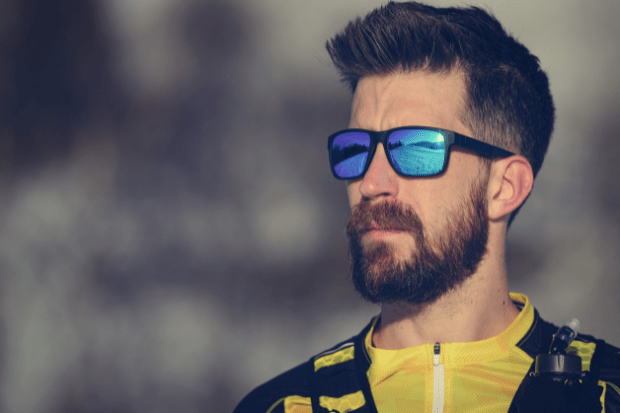Sports Prescription Lenses for Active Lifestyles

Just like each sport requires specific equipment and attire, every athlete should have specific lenses for their designated activity. Prescription lenses are designed for a particular sport and offer a range of features and technology to meet the needs of an athlete. You can optimize your vision and improve your performance by choosing the right prescription lenses for your active lifestyle.
Wearing lenses for sport
Most everyday eyeglass lenses cannot withstand impact and may shatter or break. Playing a sport with your regular glasses can be dangerous, so having protective sports prescription lenses is imperative. Though plastic and CR-39 are preferred over glass lenses, Trivex, and polycarbonate are the safest material for sports lenses. For more information about lens material, see our guide.
Key features and requirements for sports lenses
Sports lenses are designed to meet the unique demands of an active lifestyle. Key features such as lens material, lens tint, and lens treatments distinguish them from regular prescription eyewear. Sports prescription lenses should enhance contrast, reduce glare, and improve depth perception.

The Right Lenses for Your Sport
Each sport requires a unique set of visual capabilities and unique challenges. Understanding the specific needs of your sport can help you choose the right lenses to optimize your performance and protect the health of your eyes.
Lens Technologies for Specific Sports
Lens technologies designed for specific sports enhance your experience and improve your performance. Just like with everyday wear prescription lenses, the technology in sports lenses continues to advance. You may want to consider a specific lens tint or treatment for your sport, whether cycling, golf, water sports, running, or another type of athletic sport.
Lens Technologies for Specific Sports
Lens technologies designed for specific sports enhance your experience and improve your performance. Just like with everyday wear prescription lenses, the technology in sports lenses continues to advance. You may want to consider a specific lens tint or treatment for your sport, whether cycling, golf, water sports, running, or another type of athletic sport.
Cycling
Cycling demands clear vision, protection from environmental factors like wind and debris, and the ability to adapt to different lighting conditions. The best lenses for cycling should be impact resistant, enhance visual clarity, and have a photochromic treatment such as Transitions® for the right amount of tint at any light condition.
Golf
Golf is a sport that requires excellent depth perception, reduced glare, and enhanced color vision to remain under par. Polarized prescription lenses are preferred by most golfers. The lenses decrease the glare from the sun and enhance the color. Golfers can better read the greens and follow the line of the ball across the horizon when wearing polarized lenses.
Water Sports (Swimming, Surfing, etc.)
Prescription goggles are perfect for non-contact lens wearers. Prescription goggles can be ordered online pre-made or can be ordered with custom lenses for your prescription. Prescription lenses designed for water sports must reduce the glare and reflections off the water while providing UV protection.
Running and Athletics
Runners and athletes require comfort, stability, and durability from their sports prescription lenses. The lenses are designed to provide clear vision, be lightweight, and provide protection against the athlete’s environment. UV protection is important for running and other athletic events.
How to choose the correct lens for your activity
Certain lens tints and treatments may be preferable for certain sports and athletic activities.
Yellow or Orange Tints: These two tint colors increase the contrast in overcast or low-light conditions. Those who cycle, hunt, shoot, ski, snowboard, or play indoor basketball/ racquetball may prefer yellow or orange-tinted prescription lenses.
Amber, Rose, or Red Tints: These tints improve contrast in partly cloudy and sunny conditions but may cause significant color imbalance. Those who cycle, hunt, fish, ski, snowboard, or participate in watersports may prefer amber, rose, or red-tinted prescription lenses.
Dark Amber, Copper, or Brown Tints: The dark tints block blue light to enhance both contrast & visual acuity. Those who play baseball, cycle, fish, golf, hunt, ski, or participate in water activities may prefer these tint colors.
Green Tint: A green tint will mildly improve contrast, maintains color balance, and is best for baseball and golf.
Gray Tint: A gray tint reduces overall brightness but maintains 100% standard color recognition. It is preferred by many golfers.
Polarized Lenses: A polarized lens is a special type of sunglass lens with a filter that eliminates glare by allowing light to pass through in only one direction. Polarized lenses enhance contrast, reduce glare, and improve color quality. A polarized lens is available in several colors and is ideal for those who love fishing, skiing, or participating in other water or snow sports.
Photochromic Lenses: A light adaptive may also be called a photochromic lens and is often branded as a Transitions(r) lens. The lens will change from a clear to a tint with UV sun exposure. Light adaptive lenses are available in several tint colors and can be polarized. Light adaptive lenses are ideal for cyclists, pickleball players, or those who play sports during the day and evening.
Maintenance and Care for Sport Eyeglass Lenses
Proper maintenance and lens care are essential to preserve lens quality and improve the longevity of your sport prescription lenses. Both your sports glasses and everyday prescription glasses should only be cleaned with soap and water or an optical cleaner specifically made for optical lenses. Bleach or other harsh chemicals should never be used on your lenses. Lenses should be cleaned with a microfiber cloth and not the hem of your t-shirt. Rough fibers in the shirt material can scratch your lenses. Your sports eyeglasses should never be left in a hot car, or they may become warped. They should always be placed in a protective case when they are not being used.
Tips to Improve Your Vision for Sports
Sports therapy is a type of vision therapy designed to improve the visual skills of athletes. The training enables athletes to quickly and accurately recognize and process visual information. The therapy is typically a customized treatment program designed to improve and strengthen the athlete’s visual skills and re-train the eye-brain connections to interpret visual input easily and accurately. Areas of development include eye focusing, binocular vision, depth perception, body-hand-eye coordination, scanning and tracking, visual attention & processing, visual memory, and visual reaction speed.
Conclusion
Sports prescription lenses provide athletes with optimal vision, eye protection and enhance their athletic performance. By understanding the key features, lens technology, and requirements for your sport, you are better prepared to order the best prescription lenses for your sport or activity. Athletes of all levels will benefit from improved visual clarity, depth perception, and color enhancement resulting in improved athletic performance.
